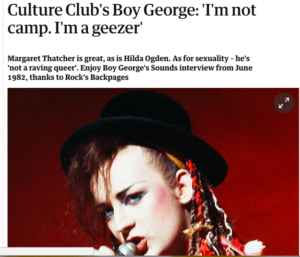 For the past couple of months, my Trailblazing Creatives partner Nicky Moran and I have been writing about clarity in all aspects of self-promotion (see links at the end of this blog).
For the past couple of months, my Trailblazing Creatives partner Nicky Moran and I have been writing about clarity in all aspects of self-promotion (see links at the end of this blog).
But now we’re moving on to the second of our ‘Six Cs’, which builds on that clarity – compelling content. Over the next couple of months Nicky and I will be exploring different aspects of this topic.
I’ve been a journalist for much of my professional life. I wrote here recently about the importance of clarity when it comes to the language you use to describe what you do and why you do it.
So to begin with, I reflected on the meaning of compelling. This is what the dictionary says: to evoke interest, attention or admiration in a powerfully irresistible way.
To be compelling means to be enthralling, captivating, gripping, spellbinding, fascinating, thrilling, convincing, persuasive, forceful, powerful, potent, credible, valid, conclusive and authoritative.
How can we consistently create content that ticks all those boxes? How can we make our communications powerfully irresistible? That seems like a big ask.
How do I know when I’m being irresistible?
I can only speak from experience.
When I was a music journalist in the 80s, I wrote some articles that, hand on heart, I can say were compelling. One was the first interview I did with Spandau Ballet, under the headline ‘The New Romantics’. That launched a movement.
Another was an interview I did with Boy George in 1982 (as he was launching his career as a singer) that was captivating enough to be reprinted by The Guardian in 2014. George was an interviewer’s dream – his quotes and humour always helped us produce compelling content.
But now that I no longer write for a national newspaper or magazine, the only benchmark I have is the number of comments I receive on a particular blog on my website or on Facebook.
So, objectively speaking, the most irresistible content I have produced in the past few months is the blog I wrote about vulnerability.
I believe these are the reasons why it resonated so much:
- I was clear about who I was writing for.
- It was highly personal and human.
- It was relevant to my audience.
- It was accessible.
- It was honest.
- It was emotional.
- I allowed my audience to find themselves in my story.
Why should I risk being irresistible?
It might feel risky, even exposing, but I have consistently found that I receive a higher level of engagement when I talk about my challenges, my pain, in an open and honest way – and when I reveal something about myself and don’t pretend that I have all the answers.
I’ve also observed the same effect when friends have posted in a similar vein – including one who shared on Facebook about how difficult it has been to put her first book out there to publishers and agents and how she realised that she was more afraid of acceptance than rejection. That post attracted a huge number of comments and likes – a great upswelling of encouragement and support.
Time and again, I observe that the more personal you can be in your storytelling and sharing, the more universally resonant it becomes.
Where can I learn how to become irresistible?
Nicky and I explored different ways of creating compelling content on our Storytelling for Self-Promotion online course, which we are hosting again at the end of April (watch this space).
As members of our first cohort shared their stories, I noticed how I started connecting with them on a whole new level.
There was one guy in the group who is a musician, producer and remixer. I knew what he did but I didn’t really get why he did it until he told his origin story. He shared more about his childhood love of classical music – especially Holst’s The Planets – and how he now wants to unite lovers of classical and electronic dance music. That got me curious enough to want to listen to his music, which I did – and I love it. I don’t think I would have listened had I not read the story first.
Another member of the group – an artist – told the story of how he decided to drop everything and move to Greece. While unpacking boxes in his new home, he came across a gift his dad gave him when he was 12 – a book about graphic design he hadn’t opened in more than 20 years.
The images in that book were produced a century ago and reminded him why he wanted to be a designer in the first place. Finding the book gave him a new lease of life and connected him to his love for his dad again. From then on his mission has been to work as if he were a designer from a bygone age.
He’s already a compelling artist but this gave more depth and meaning to the art he produces. The story gives him an irresistible hook.
So here are a few questions for you:
When have you been as irresistible as Boy George?
When have you created intrigue, curiosity or fascination?
When have you been convincing and persuasive?
And how can you keep doing that on a regular basis?
Do share your secrets in the comments below…
The clarity series:
Clarity about what you want to be known for
Clarity about describing what you do
Clarity about why you do what you do
Clarity about your audience
Clarity about what you want to commit to
Clarity about the language you use
Clarity about what you want to manifest
Leave a Reply